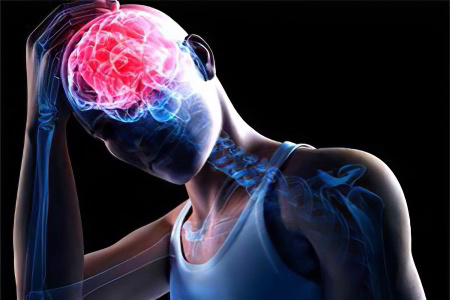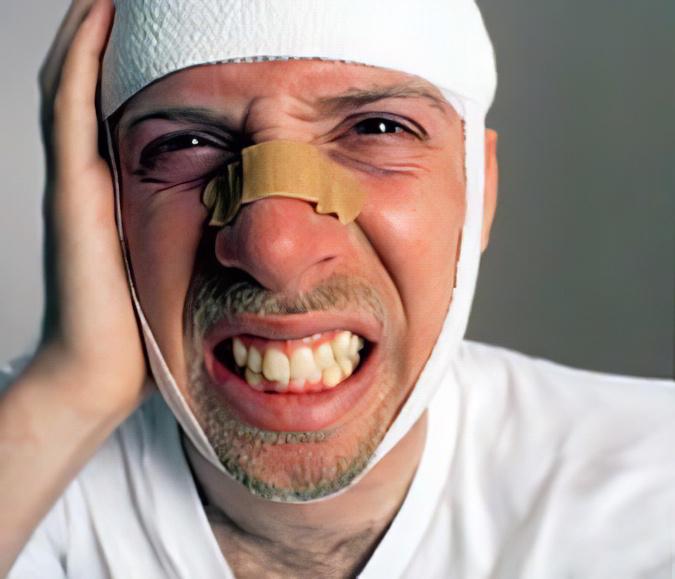Concussion accounts for 70 to 80% of the total number of all CNS injuries. This type of injury is of great importance for both the social and medical spheres.
The reasons for the increased attention to the problem of treatment and diagnosis of brain damage:
A wide range of spheres of human activity in which there is a possibility of getting this injury - household, sports, children, industrial, transport, etc.
The difficulty of diagnosing this condition due to the difficulty of differentiating with diseases similar in symptomatology - osteochondrosis of the cervical spine, chronic cerebrovascular insufficiency, hypertension, a combination of concussion with the intake of large doses of alcohol, the absence of specific symptoms, unpredictability of dynamics and scarcity of manifestations. In half of the recorded cases, there is either overestimation or underestimation of the severity of the patient's condition.
Insufficient qualifications of medical personnel who do not have specialization in this area.
Postcommational syndrome, expressed in the symptoms of the immediate and long-term consequences of trauma.
Based on the results of such studies, it can be concluded that not only severe trauma, but also mild brain damage is subject to treatment.

A concussion is damage to the bones of the skull or soft tissues, such as brain tissue, blood vessels, nerves, and meninges. An accident can happen to a person, in which he can hit his head on a hard surface, this just entails such a phenomenon as a concussion. In this case, some disturbances in the functioning of the brain occur, which do not lead to irreversible consequences.
There is no exact description of the course of all stages of this pathogenic process, but most experts argue that with a concussion, dysfunctions of nerve cells occur: their nutrition deteriorates, a slight displacement of the layers of brain tissue appears, and the connection between brain centers collapses. As a result, multiple microshibs, numerous minute perivascular edema and hemorrhages develop. At the same time, obvious morphological changes and changes on MRI are not observed.
Severe concussion is dangerous because it can severely injure certain areas of the brain or rupture of blood vessels inside the skull.
From such a traumatic brain injury, a person can lose consciousness lasting from a couple of seconds to several minutes. The time spent unconscious is used to determine the severity of the concussion. The extreme form is coma.
When the victim comes to his senses, he often does not understand where he is and what happened to him. Sometimes - does not recognize others. The severity of the injury can also be judged by retrograde amnesia: the longer the period of time lost from memory, the more serious the damage. The appearance of these signs is due to the fact that the vital centers of the brain are affected - the regulation of respiration and cardiovascular activity.
In the first hours or days after the concussion, the victim turns pale, complains of weakness and dizziness, tinnitus. The headache is pulsating in nature and is localized in the back of the head. Nausea and vomiting may appear, breathing becomes more frequent, the pulse changes in the direction of increasing or slowing down. After a while, these indicators will normalize. Depending on the injury itself and on the accompanying stress factors, blood pressure can either quickly return to normal or rise. Body temperature remains unchanged.
In connection with the dysfunction of the nerve cells of the brain after a concussion, negative phenomena are observed in the organs of vision: pain when moving the eyes, difficulty focusing the gaze, narrowed or dilated pupils, pupils of different sizes, divergence of the eyeballs when reading.
Other symptoms may include sweating, flushing, discomfort, or sleep disturbances.
During the first two weeks, the general condition of the victim improves. However, it should be borne in mind that health disorders can last much longer. For example, headache in those who suffer from essential hypertension is particularly intense.
With a concussion, symptoms are largely subjective. Often they are determined by the age factor. In infants and young children, concussion occurs without loss of consciousness. During the blow, the skin turns pale (especially the face), the heart rate increases. A little later, drowsiness and lethargy appear. When feeding, regurgitation and vomiting occur more frequently than usual. Sleep disorders and general anxiety have been reported.
In preschool children, all manifestations from concussion disappear within two to three days.
Young and middle-aged people lose consciousness at the time of trauma much more often than children and old people. At the same time, the representatives of the older generation show a pronounced disorientation in space and time.
As a rule, for most people, the neurologic symptoms of a mild concussion resolve within a few weeks. However, after any concussion, the energy metabolism in the brain remains in an altered state for a long time (a year or longer).

In order to help a victim with a traumatic brain injury resulting from an accident, it is important to identify the symptoms accompanying a concussion. It should be noted that not all of the following symptoms may appear immediately. It all depends on the severity of the concussion; some symptoms may not appear at all.
The most common symptoms of a concussion are:
Nausea and gag reflex in the case when it is not known about what happened to the person and he is unconscious;
Headache is normal after hitting a person's head;
The victim wants to sleep or, on the contrary, is hyperactive;
A lack of coordination also testifies to a brain injury, and a person is also dizzy;
One of the most important symptoms is loss of consciousness. The time of loss of consciousness can be long or, conversely, short;
It is necessary to check the size of the pupils: with a concussion, pupils of different shapes are possible;
Direct confirmation of concussion seizures;
If the victim is conscious, he may experience discomfort in bright light or loud sound;
When talking with the victim, he may experience confusion. He may not even remember what happened before the accident;
Sometimes speech may not be coherent.
After a while, all signs of a concussion weaken and completely disappear. If the symptoms persist for a long time, this may indicate more serious disorders that have occurred in the work of the brain. Perhaps this speaks of cerebral edema, bruising, or cerebral hematoma.

Concussion can be caused by bruises, impacts, or sudden movement (both acceleration and deceleration). The most common causes of concussions are road traffic accidents, work, sports or domestic injuries.
Criminal circumstances can also play a negative role.
Mechanical causes of traumatic brain injury
Having an understanding of the mechanisms of brain injury, it is possible to predict the consequences of even the most insignificant forms of concussion in different age categories.
Cerebrospinal fluid (CSF), which fills the closed space between the brain and the bones of the skull, protects the brain floating in it from serious physical influences. During a sudden blow, the brain for some time by inertia moves in the opposite direction. The pressure of the cerebrospinal fluid between the inner lining of the skull and the brain at this moment increases many times. As a result, the brain receives a mechanical or hydraulic shock.
The counter-shock on the side opposite to the area of increased pressure creates the same force with a minus sign. Forced vibrations produced by the brain, "floating" in the cerebrospinal fluid, subject it to repeated damage. In addition, the brain receives additional trauma as a result of its rotational displacements around the axis, as a result of which it hits the protrusions of the skull. There is a directly proportional relationship - the more sudden and strong the mechanical impact was, the more significant damage the brain received.
Biological causes of traumatic brain injury
The cerebral vessels during this injury do not receive significant damage, however, the concussion triggers the mechanism of inadequate reactions of the vessels themselves, the nerve cells of the brain and the intracranial nerve pathways. Studies carried out with the participation of animals, after modeling their concussion, showed the following results: when examining brain tissue under a microscope, displacements of the nuclei of nerve cells, damage to their elements - membranes, mitochondria, as well as pathologically altered space between them, an increase in the size of axons (nerve fibers).
Such injuries indicate that there is a traumatic brain disease.
Symptoms of a traumatic illness:
Pathological dilation of cerebral vessels that occurs after their initial spasm leads to impaired cerebral circulation. It quickly recovers with mild concussion, but this recovery is uneven in different departments. Complications of this process are slowing down of blood flow, overflow of blood vessels, intracellular edema.
Changes in the metabolism of brain structures, colloidal balance, chemical and physical properties of the medulla arising from changes in intracranial pressure at the time of traumatic exposure. Studies carried out with the participation of experimental animals have recorded in rodents an increased vulnerability of nerve cells, a violation of the extracellular and intracellular metabolism of ions, an imbalance between the supply of energy with blood cells and the need for it.
A short-term violation of axonal conduction, expressed in the loss of interconnections between nerve cells and centers of regulation of their vital activity. At the same time, the structure of nerve tissues maintains physical integrity.
Impaired coordination between important functional centers of the cerebral hemispheres (respiration, thermoregulation, cardiovascular activity) due to the rupture of connections between them and the rest of the brain due to rotational displacement.
Analysis of the mechanism of concussion makes it possible to adequately assess the symptoms of trauma and the tactics of first aid.
A sleepless night is tantamount to a concussion
According to a study conducted by Swedish scientists, a night without sleep, regardless of the reason for it (insomnia, night shifts, entertainment), is equated in its consequences with a concussion. A sleepless night negatively affects a person's health, performance and mood.
Their findings were confirmed by data from an experiment conducted at the University of Uppsala, with 15 volunteers in excellent health. The results of blood samples taken from participants after a sleepless night were analyzed. Brain damage was evidenced by 20% increased levels of calcium binding protein (S-100B) and neuron-specific enolase (NSE). This is a dangerous sign, since the indicators differ from the norm, but are close to those in patients after a concussion.
During a sleepless night, there is no cleansing of the tissues of the human body at the cellular level from toxins received during wakefulness. Violation of this physiological process leads to an increase in the biochemical parameters of the blood of the concentration of markers, similar with the same results after a concussion. Symptoms experienced by those who were forced to spend a night without sleep are similar to those of a concussion: headache, noise in the head, impaired memory and attention, nausea.
Toxins tend to accumulate in the body, so several sleepless nights in a row are comparable in severity to physical brain injury.

The list of complications that can occur after traumatic brain injury is very diverse. The most common is the so-called post-concussion syndrome. After some time - and it can be days, months, and sometimes even years - a person begins to worry about headaches. These pains can be excruciating - the head is splitting, so to speak. A person is disturbed by disturbing thoughts, he is irritated, he cannot concentrate on something specific. Sleep is disturbed, it becomes very difficult to do work.
In such a situation, it is necessary to start treatment with medications. Seeing a psychotherapist does not bring relief. When prescribing narcotic painkillers, it is important to remember the negative consequences of drug addiction.
For treatment, it is very important to observe rest and strict bed rest. There should be no bright light in the room to avoid pain. Of the drugs used are sedatives, hypnotics and pain relievers. Elderly people are treated for multiple sclerosis and its accompanying diseases.
In order to avoid complications after a traumatic brain injury, dispensary observation for one year by a neurologist in a polyclinic at the place of residence is necessary.
Boxing people may experience "boxer's encephalopathy" as a complication. Its symptoms are as follows: imbalance, mental changes and tremors of the limbs.
Treatment principles
Most often, a concussion occurs due to mechanical injury, so the first thing that is required is to provide first aid. If the victim quickly regained consciousness or did not lose consciousness, lay him on a horizontal surface so that his head was slightly raised. If a person is unconscious, turn him to his right side, tilt his head back, turn his face to the ground, bend your left leg and arm at right angles at the knee and elbow joints. In this position, air will easily pass into the lungs, the risk of airway blockage will disappear.
Immediately after the concussion, the victim must be taken to the hospital. Symptoms of different traumatic brain injuries may initially be identical, therefore, based on the results of an X-ray examination, the doctor will make an accurate diagnosis. The victim is prescribed bed rest for at least two days. In this case, complete rest is necessary: it is forbidden to watch TV, read and listen to music. The spectrum of prescribed medications is mainly aimed at relieving dizziness, headache, insomnia and anxiety.
As a rule, the condition of the victims returns to normal within one to two weeks after the injury, but it is important to know that 35% of mild concussions lead to serious complications if the disease is carried on the legs. In this case, there is a danger of developing post-traumatic neurosis or epilepsy. In special cases, neurosurgical intervention may be required.
In older people, concussion causes neurological symptoms, vascular complications, high blood pressure, and increases the risk of stroke and Alzheimer's disease. To prevent the negative consequences of this category of persons, in addition to direct treatment, anti-sclerotic therapy is prescribed.
Patients with a history of concussion are registered with a neurologist for a year. During this observation, the probable consequences of the trauma, negatively affecting the patient's quality of life, are monitored, and the consequences of a concussion are treated.
The main principle of treatment of the consequences of trauma is bed rest for 10 to 14 days, rest for the nervous system, created by refusal to read, watch TV and listen to music.
Medications for the treatment of concussion:
Calming and hypnotics - Finlepsin, Phenobarbital;
Drugs with an anticonvulsant effect and arresting the activity of the reticular formation are tinctures of hawthorn and motherwort, Phenibut, Phenazepam, Nosepam.
Vasodilator and decongestants - Eufillin, Memoplant, Cavinton, Sermion, Trental.
Antioxidants that inhibit oxidation processes and minimize the formation of free radicals - Mexiprim, Mexidon, Glycine.
Drops with intravenous drip of electrolytes, carried out in the treatment of children with severe concussion to replenish potassium ions in damaged cells.
In most cases, no specific treatment is prescribed for the treatment of concussion. Symptoms such as asthenia and dizziness are relieved by the following drugs: vitamin B, Betaserx, Westinorm, hawthorn and motherwort tincture.